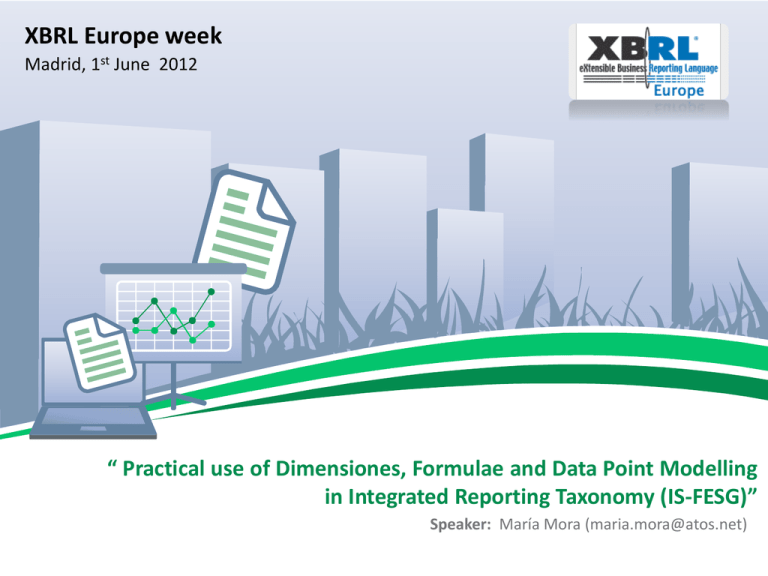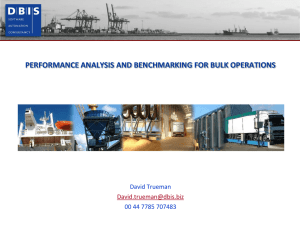Practical use of Dimensions, Formulae and Data Point
advertisement

XBRL Europe week Madrid, 1st June 2012 “ Practical use of Dimensiones, Formulae and Data Point Modelling in Integrated Reporting Taxonomy (IS-FESG)” Speaker: María Mora (maria.mora@atos.net) “ Practical use of Dimensiones, Formulae and Data Point Modeling in Integrated Reporting Taxonomy (IS-FESG)” The evolution: Business Reporting VS XBRL standard Integrated Reporting › Why the need of Integrated Reporting? › What is the main goal? The taxonomy : Integrated Scoreboard of Financial, Environmental Social and Governance indicators (IS-FESG) › Dimensions + Data Point Modeling › Formulae › Financial relationship: IFRS, USGAAP, IPP and PGC2007 › Risk relationship: COREP › Data identification relationship: Data of General Identifications Taxonomy (DGI) XBRL Europe Week 2012 | página 1 “ Practical use of Dimensiones, Formulae and Data Point Modeling in Integrated Reporting Taxonomy (IS-FESG)” The evolution: Business reporting VS XBRL standard KPI Entity Financial Historical 2003 XBRL 2.1 2005 Dimensions 1.0 Specification 2009 Formula 1.0 Specification Prospective 2011 DPM XBRL Europe Week 2012 | página 2 “ Practical use of Dimensiones, Formulae and Data Point Modeling in Integrated Reporting Taxonomy (IS-FESG)” Why the need of Integrated Reporting? – Actual state The economic uncertainty and the lack of confidence, makes pay more attention to the investment strategies and quick decision making. The business information is an element of competitive advantage. The large volume of data, disjointed, irrelevant, with a little strategic significance, does not convey the real state of a company. What is the main goal ? Connect financial and nonfinancial information in a unique block › Connecting financial, social, environmental and government information. › Containing quantitative and qualitative information truly relevant about strategy . › Creating value for the shareholders and stakeholders › Promoting the exercise of Corporate transparency XBRL Europe Week 2012 | página 3 “ Practical use of Dimensiones, Formulae and Data Point Modeling in Integrated Reporting Taxonomy (IS-FESG)” The taxonomy for Integrated Reporting - (IS – FESG Taxonomy) In a format Clear KPI Concise Entity Financial Consistent Comparable Historical Prospective Brings together Financial Environmental Social Corporate Governance XBRL Europe Week 2012 | página 4 “ Practical use of Dimensiones, Formulae and Data Point Modeling in Integrated Reporting Taxonomy (IS-FESG)” KPI indicators Financial Indicators Economic efficiency KPI_F1 Revenues KPI_F2 Suppliers expenses KPI_F3 Added Value KPI_F4 Employee compensation KPI_F5 Gross Profit KPI_F6 Financial expenses KPI_F7 Owners retribution KPI_F8 Public Administration expenses KPI_F9 Economic contribution to the community KPI_F10 R&D&I investment KPI_F11 Profitability KPI_F12 Level of debt KPI_F13 Treasury shares Environmental indicators Energy efficiency KPI_E1 Energy consumption KPI_E2 Water consumption KPI_E3 Polluting emissions Waste reduction efficiency Waste generation KPI_E5 Waste processed Social indicators Human Capital KPI_E4 Social indicators KPI_S3 Employees Gender diversity of employees Top employees KPI_S4 Gender diversity of top employees KPI_S5 KPI_S7 Job stability Absentee Employee turnover KPI_S8 Net creation of new jobs KPI_S9 Seniority Employees training KPI_S1 KPI_S2 KPI_S6 KPI_S10 Social Capital KPI_S11 Non-compliance with legal regulation concerning customers Locally-based suppliers KPI_S13 Payment period to suppliers Corporate Governance indicators Fair corporate governance KPI_CG1 Board members KPI_CG2 Independent board members KPI_CG3 CSR Board members KPI_CG4 Executive Committee KPI_CG5 Audit Committee KPI_CG6 Nominations Committee KPI_CG7 Meetings of the Board KPI_CG8 Total remuneration of the Board KPI_CG9 Gender diversity at Management Board KPI_S12 XBRL Europe Week 2012 | página 5 “ Practical use of Dimensiones, Formulae and Data Point Modeling in Integrated Reporting Taxonomy (IS-FESG)” Representation of the Business reality KPI Entity Financial Historical Prospective XBRL Europe Week 2012 | página 6 “ Practical use of Dimensiones, Formulae and Data Point Modeling in Integrated Reporting Taxonomy (IS-FESG)” New levels of complexity (Basic, composed and complex indicators) KPI F1 /(S2+E2) Complex Indicators Entity Financial Historical S1/S2 Prospective E1/E2 Composed Indicators Financial Social Profit People F1 S1 S2 Environmental Governmental Planet E1 Pilots G1 Basic Indicators XBRL Europe Week 2012 | página 7 “ Practical use of Dimensiones, Formulae and Data Point Modeling in Integrated Reporting Taxonomy (IS-FESG)” Examples - different levels of KPI complexity Financial Indicators Economic efficiency KPI_F1 Revenues KPI_F2 Suppliers expenses KPI_F3 Added Value Revenues KPI_F4 Employee compensation KPI_F5 Gross Profit KPI_F6 Financial expenses Basic KPI_F7 Owners retribution KPI_F8 Public Administration expenses KPI_F9 Economic contribution to the community KPI_F10 R&D&I investment KPI_F11 Profitability KPI_F12 Level of debt KPI_F13 Treasury shares Environmental indicators Energy efficiency KPI_E1 Energy consumption Employee Compensation Revenues Composed XPATH Expression: abs($composedEmployeeBenefits - ($basicEmployeeBenefits div $basicRevenue)) le threshold XBRL Europe Week 2012 | página 8 “ Practical use of Dimensiones, Formulae and Data Point Modeling in Integrated Reporting Taxonomy (IS-FESG)” Example - different levels of KPI complexity Financial Indicators Economic efficiency KPI_F1 Revenues KPI_F2 Suppliers expenses KPI_F3 Added Value KPI_F4 Employee compensation KPI_F5 Gross Profit KPI_F6 Financial expenses KPI_F7 Owners retribution KPI_F8 Public Administration expenses KPI_F9 Economic contribution to the community KPI_F10 R&D&I investment KPI_F11 Profitability KPI_F12 Level of debt KPI_F13 Treasury shares Environmental indicators Energy efficiency KPI_E1 Energy consumption KPI_E2 Water consumption KPI_E3 Polluting emissions Waste reduction efficiency KPI_E4 Waste generation KPI_E5 Waste processed Energy consumption Revenues Complex XPATH Expression: abs($composedEnergyConsumption - ($basicEnergyConsumption div $basicRevenue)) le threshold XBRL Europe Week 2012 | página 9 “ Practical use of Dimensiones, Formulae and Data Point Modeling in Integrated Reporting Taxonomy (IS-FESG)” Total of 30 formulas BASIC bh-01 bv-01 bh-02*** Added Value=Revenue -supplier Fullfillment=reported/expected Gross profit=Added value - Employee benefits COMPOSED cpd-01 cpd-02 cpd-03 cpd-04 cpd-06 cpd-07 cpd-08 cpd-09 cpd-10 cpd-11 cpd-12 cpd-13** cpd-14 cpd-15 cpd-16 cpd-17 cpd-18 cpd-19 cpd-20 cpd-21 cpd-22 Suppliers Expenses/Revenues Added Value/Revenues Employee benefits/Revenues Financial expense/Revenues Public Administration expenses /Revenues Economic contribution to the community/Revenues Water consumption/Energy consumption Polluting emissions/Energy consumption Waste generation/Energy consumption Waste processed/Energy consumption Gender diversity of employees/Employees Gender diversity of top employees/Top employees Job stability/Employees Employee turnover/Employees Seniority/Employees Employees training/Employees Independent board members/Board member Executive Committee/Board members Audit Committee/Board members Nominations Committee/Board members Gender diversity at Management Board/Board members COMPLEX cpx-01 cpx-02 cpx-03 cpx-04*** cpx-05*** Energy consumption/Revenues Polluting emissions/Revenues Employee benefits/Employees Energy consumption/Gross profit Polluting emissions/Gross profit cpx-06*** Total Remuneration board/Gross profit XBRL Europe Week 2012 | página 10 “ Practical use of Dimensiones, Formulae and Data Point Modeling in Integrated Reporting Taxonomy (IS-FESG)” Architecture of the taxonomy - (European, American and Spanish) Listed and non companies and SMEs XBRL Europe Week 2012 | página 11 “ Practical use of Dimensiones, Formulae and Data Point Modeling in Integrated Reporting Taxonomy (IS-FESG)” XBRL shows new possibilities to discover This proposed IS-FESG taxonomy architecture the promotes taxonomy extensions, for a double purpose: › From the issuer´s perspective: extend the taxonomy, by adding new columns (dimensions) or validation rules (formulae), • Increasing the complexity of the public reports, • Adapting to the behaviors that the stakeholders and entity managers will be required to monitor . › From the analyst´s perspective: use additional dimensional relationships and/or formulae to perform specific treatments on entity data, at the taxonomy layer, without the need for software re-programming. XBRL Europe Week 2012 | página 12 “ Practical use of Dimensiones, Formulae and Data Point Modeling in XBRL Europe week Integrated Reporting Taxonomy (IS-FESG)” Madrid, 1st June 2012 Thanks for your attentions Thank you for your attention María Mora (maria.mora@atos.net) XBRL Europe Week 2012 | página 13








